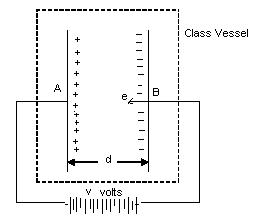Movement Of A Free Electron In An Electric Field
Movement Of A Free Electron In An Electric Field Assignment Help | Movement Of A Free Electron In An Electric Field Homework Help
Movement of A Free Electron In An Electric Field
Let A and B be the two metal plates, d meters apart, in an evacuated alas vases and V be the potential difference across the plates.
Electric field strength E = V volts/m
d
If an electron were released from the negative plate B, then the work done in moving the electron from plate B to plate A
= Force on an electron x distance moved
= eEx d =e x V x d = eV joules
d
Where e is the negative charge, in coulombs, on the electron.

If the initial and final velocities of the electron are zero and v metres per second respectively, then the final kinetic energy of electron, immediately before its impact with plate A, is 1 mv2 joules, where m is
2
the mass of electron in kg. Since there are no gas molecules in the space between the plates A and B, there can be no loss of energy by collision of the electron with such molecules and all the work done on the electron is converted in to kinetic energy,
1 mv2 = eV
2
and v = √2eV m/s
m
This kinetic energy is converted into heat at the moment of impact of the electron with plate A.
A more convenient unit for such amount of energy is the electron volt, which is equal to the work done when an electron is moved through a p.d. of I volt, hence
I electron volt = 1.6 x 1019C
For more help in Movement of A Free Electron In An Electric Field click the button below to submit your homework assignment
Electric field strength E = V volts/m
d
If an electron were released from the negative plate B, then the work done in moving the electron from plate B to plate A
= Force on an electron x distance moved
= eEx d =e x V x d = eV joules
d
Where e is the negative charge, in coulombs, on the electron.
If the initial and final velocities of the electron are zero and v metres per second respectively, then the final kinetic energy of electron, immediately before its impact with plate A, is 1 mv2 joules, where m is
2
the mass of electron in kg. Since there are no gas molecules in the space between the plates A and B, there can be no loss of energy by collision of the electron with such molecules and all the work done on the electron is converted in to kinetic energy,
1 mv2 = eV
2
and v = √2eV m/s
m
This kinetic energy is converted into heat at the moment of impact of the electron with plate A.
A more convenient unit for such amount of energy is the electron volt, which is equal to the work done when an electron is moved through a p.d. of I volt, hence
I electron volt = 1.6 x 1019C
For more help in Movement of A Free Electron In An Electric Field click the button below to submit your homework assignment